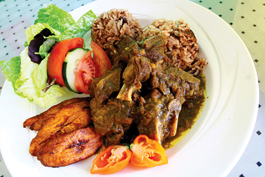home | metro silicon valley index | silicon valley restaurants | review

Goats in your back yard: Menlo Park's Jamaican restaurant serves up goat curry
Let's Goat
Forget spring lamb, and try the other red meat
By Cheryl Sternman Rule
GOAT is the other red meat. It's low in fat and cholesterol, rich in flavor and tender as all get-out when properly prepared. While it's not likely to win a popularity contest with hamburger or pork chops, diners are starting to discover what millions around the world have known for years—goat meat makes for mighty fine eating.
Jim Wimborough is chef at Evvia, a celebrated Greek restaurant in Palo Alto. He isn't Greek himself, but working in an upscale Greek restaurant had led him to appreciate goat meat's succulence and versatility.
"[Goat] sells very well," he says. "It has actually become one of our signature dishes." He gets his milk-fed goat from Don Watson, owner of the Napa Valley Lamb Co. Watson also runs Wooly Weeders, a roving mowing service that rents out herds to areas with brush so overgrown it poses a fire hazard.
Katsiki yiouvetsi ($26.75), the restaurant's traditional preparation of braised goat with pearl onions, artichoke hearts and feta cheese, is a permanent fixture on Evvia's menu. Wimborough also offers a different rotisserie dish each night, including spit-roasted whole goat marinated in olive oil, lemon juice, Greek oregano and salt. This special is most popular in the spring, as Greeks traditionally celebrate Easter with a rotisserie goat or lamb.
"All our Greek customers and employees want us to order extra goats for them for Easter," he says. Of course, Greeks hardly have a corner on the market. Chef Robert Simpson of Back A Yard in Menlo Park also grew up eating the animals in his native Jamaica. With hilly terrain and plenty of available land, Jamaica and its Caribbean neighbors are the ideal landscape for free-roaming goats.
"Goat has its own distinct flavor," Simpson says. "It's a bit gamey but has subtle undertones, not like lamb or venison. It's less pungent. In Jamaica, you can't have a big party without curried goat." His village in the Blue Mountains outside Kingston even had a designated goat cook, and Simpson, ever the budding chef, would regularly roll up his sleeves and get messy. "As a youngster, I was always helping to butcher the goat for parties," he says.
Jamaicans, like goat-eaters elsewhere, don't let any part of the animal go to waste, and making soup is a popular way to extend the value of all that protein. According to Simpson, "manish water," or goat soup, develops a toasty flavor after cooking for up to five hours over an open fire. The animal's roasted head as well as its feet, innards and cleaned tripe, plus green bananas, vegetables, herbs, garlic and white rum, all go into the soup pot. The goat's skin is often used to make drums, and, in another preparation, their scrotums are roasted over high heat until cooked and barely charred.
"This might sound gross" to the uninitiated, admits Simpson, "but honestly, it was the thing to do. Delicious."
I can personally attest to Simpson's talent: his curried goat at Back A Yard is terrific. The meat falls off the bone in soft, silky shreds and is sauced with a complex West Indian curry blended with turmeric and orange rind. The dish ($8.95 small, $11.95 large, available Thursdays and Saturdays only) also comes with two generous mounds of red beans and rice, tender fried plantains and a crisp green salad. It moves quickly, regularly selling out.
"Two Saturdays ago it was nonstop goat," he says. "A lot of people who dine here are very open-minded."
Chef Ismael De Gante of Consuelo Mexican Bistro in San Jose grew up in Mexico City and says consuming goat meat is common in several Mexican states. In Nuevo Leon, Sonora and San Luis Potosi in the north, cabrito al pastor (seasoned whole goat slowly roasted over an open fire) and cabrito al horno (goat wrapped in banana leaves and served as a soup) are both popular. In the centrally located states of Hidalgo, Tlaxcala and Queretaro, goat is cooked underground for about eight hours (barbacoa de hoyo) and is also salted and served as jerky (chito). De Gante recalls eating goat at family reunions.
But you won't find goat meat on Consuelo's menu. (You will, however, find goat cheese, De Gante points out.) Fortunately, birria, a goat meat stew, turns up at many taquerias and Mexican restaurants on the weekends.
Many nonvegetarians across South Asia also enjoy goat meat, says Mohamed Rahman of Cafe Dhaka, a small Bangladeshi restaurant in Santa Clara serving several goat dishes. The same also holds true across the Middle East where halal dietary laws prohibit Muslims from eating pork.
At the International Food Bazaar's Halal Meat Market in San Jose, butcher Jasim Al-asidi, a native Iraqi, displays his goats' wares in all their glory. He sells the animals' hearts, kidneys, livers, tripe, heads, shoulders, legs and testicles. Many of his customers also order whole goats.
"In the Middle East," he says, "it's common to eat goats for celebrations and on holidays like Eid and Ramadan. ... Americans eat beef, always steak," he adds, sounding almost bewildered.
It could be time to branch out.
Back A Yard
1189 Willow Road, Menlo Park
650.323.4244
Cafe Dhaka
3284 El Camino Real, Santa Clara
408.985.1841
Consuelo Mexican Bistro
377 Santana Row, San Jose
408.260.7082
Evvia
420 Emerson St., Palo Alto
650.326.0983
International Food Bazaar/Halal Meat Market
2052 Curtner Ave., San Jose
408.559.3397
Send a letter to the editor about this story.
|
|
|
|
|
|